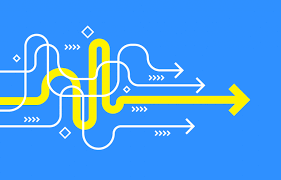Environmental Graphic Design: Blending Creativity with Functionality
Environmental graphic design is a specialized field that focuses on creating visual experiences in physical spaces. It involves the strategic use of graphics, signage, wayfinding systems, and architectural elements to enhance the overall environment and communicate information effectively.
Unlike traditional graphic design, which is primarily focused on two-dimensional mediums such as print and digital, environmental graphic design considers the three-dimensional aspect of space. It aims to create cohesive and immersive experiences that engage and guide people within a built environment.
One of the key objectives of environmental graphic design is wayfinding – helping people navigate complex spaces such as airports, museums, hospitals, and campuses. By strategically placing signage, maps, and visual cues, designers can improve the user experience and reduce confusion.
In addition to wayfinding, environmental graphic design also plays a crucial role in branding and storytelling. By incorporating brand elements into the physical environment, designers can reinforce brand identity and create memorable experiences for visitors.
Another important aspect of environmental graphic design is sustainability. Designers are increasingly incorporating eco-friendly materials and practices into their projects to minimize environmental impact and promote sustainable design principles.
Overall, environmental graphic design represents a harmonious blend of creativity and functionality. It has the power to transform ordinary spaces into extraordinary ones, creating meaningful connections between people and their surroundings.
6 Benefits of Environmental Graphic Design: Enhancing Spaces and Experiences
- Enhances user experience by improving wayfinding and navigation in complex environments.
- Strengthens brand identity and creates a cohesive brand experience across physical spaces.
- Promotes sustainability through the use of eco-friendly materials and practices.
- Creates immersive and engaging environments that leave a lasting impression on visitors.
- Helps communicate information effectively through visual elements integrated into the environment.
- Blends creativity with functionality to transform spaces into visually compelling experiences.
Challenges of Environmental Graphic Design: Costs, Maintenance, Flexibility, and Visual Clarity
- Costly to implement, especially for large-scale projects that require extensive signage and branding elements.
- Maintenance can be challenging, as environmental graphics may degrade over time due to exposure to weather and wear.
- Limited flexibility in making changes or updates once the design is installed in a physical space.
- Potential visual clutter or sensory overload if not carefully planned and executed, leading to confusion rather than clarity.
Enhances user experience by improving wayfinding and navigation in complex environments.
Environmental graphic design excels in enhancing user experience by significantly improving wayfinding and navigation in intricate environments. By strategically placing signage, maps, and visual cues, designers ensure that individuals can easily orient themselves and navigate through complex spaces such as airports, museums, hospitals, and campuses. This proactive approach not only reduces confusion but also fosters a sense of comfort and efficiency for users as they move through the environment with ease.
Strengthens brand identity and creates a cohesive brand experience across physical spaces.
Environmental graphic design excels in strengthening brand identity by seamlessly integrating brand elements into physical spaces, creating a cohesive brand experience that resonates with visitors. By strategically incorporating logos, colors, and messaging in architectural elements, signage, and wayfinding systems, environmental graphic design ensures that the brand’s essence is consistently communicated across various touchpoints. This unified approach not only reinforces brand recognition but also fosters a sense of connection and familiarity for individuals interacting with the space, ultimately enhancing their overall brand experience.
Promotes sustainability through the use of eco-friendly materials and practices.
Environmental graphic design promotes sustainability by prioritizing the use of eco-friendly materials and practices. By incorporating sustainable elements into design projects, such as utilizing recycled materials, low-VOC inks, and energy-efficient lighting, designers can minimize environmental impact and contribute to a greener future. This focus on sustainability not only benefits the environment but also raises awareness about the importance of responsible design practices in creating a more sustainable world for generations to come.
Creates immersive and engaging environments that leave a lasting impression on visitors.
Environmental graphic design excels in creating immersive and engaging environments that leave a lasting impression on visitors. By strategically integrating visual elements, signage, and wayfinding systems, designers can transform physical spaces into captivating experiences that resonate with individuals long after they have left. This pro highlights the ability of environmental graphic design to not only enhance the aesthetic appeal of a space but also to evoke emotions, foster connections, and make a memorable impact on those who interact with the environment.
Helps communicate information effectively through visual elements integrated into the environment.
Environmental graphic design excels in its ability to effectively communicate information through seamlessly integrated visual elements within the environment. By strategically placing signage, wayfinding systems, and other graphic components in physical spaces, this design approach ensures that essential information is conveyed clearly and efficiently to guide and inform individuals navigating the environment. Through thoughtful placement and design, environmental graphic design not only enhances the aesthetic appeal of a space but also facilitates seamless communication, ultimately improving user experience and engagement.
Blends creativity with functionality to transform spaces into visually compelling experiences.
Environmental graphic design excels in blending creativity with functionality to transform ordinary spaces into visually compelling experiences that captivate and engage visitors. By strategically incorporating graphic elements, signage, and architectural features, designers have the ability to not only enhance the aesthetic appeal of a space but also ensure that it serves a practical purpose. This unique approach allows for the creation of immersive environments that tell stories, evoke emotions, and leave a lasting impact on those who interact with them.
Costly to implement, especially for large-scale projects that require extensive signage and branding elements.
One significant drawback of environmental graphic design is the high cost associated with its implementation, particularly for large-scale projects that demand extensive signage and branding elements. The expenses involved in designing, producing, and installing these components can quickly add up, posing a financial challenge for organizations looking to enhance their physical spaces. Budget constraints may limit the scope of creative possibilities and force compromises in the quality or quantity of environmental graphics, ultimately impacting the overall effectiveness of the design solution.
Maintenance can be challenging, as environmental graphics may degrade over time due to exposure to weather and wear.
One significant drawback of environmental graphic design is the challenge of maintenance. As these graphics are often exposed to the elements and subject to wear and tear, they can degrade over time. Weather conditions, such as sunlight, rain, and wind, can cause fading and deterioration of the materials used in environmental graphics. Additionally, heavy foot traffic or physical contact can lead to damage that requires frequent upkeep and replacement, making maintenance a continuous and costly aspect of managing environmental graphic installations.
Limited flexibility in making changes or updates once the design is installed in a physical space.
One significant drawback of environmental graphic design is the limited flexibility in making changes or updates once the design is installed in a physical space. Unlike digital or print designs that can be easily modified or replaced, environmental graphics are often permanent fixtures that require significant effort and resources to alter. This lack of agility can pose challenges when adjustments are needed due to evolving requirements or branding changes, potentially leading to costly and time-consuming redesign processes.
Potential visual clutter or sensory overload if not carefully planned and executed, leading to confusion rather than clarity.
One significant con of environmental graphic design is the potential for visual clutter or sensory overload if not carefully planned and executed. When an excessive amount of graphics, signage, and visual elements are introduced into a space without thoughtful consideration, it can overwhelm the viewer and create confusion rather than clarity. This can hinder the intended purpose of the design, making it challenging for individuals to navigate or understand the information being communicated effectively. Therefore, meticulous planning and strategic placement of graphic elements are essential to ensure that environmental graphic design enhances the user experience without causing sensory overload.




